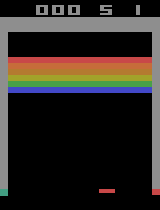Deep Q-learning Network (DQN) can be used to train an agent to play Atari games:

We often use continuous frames to represent an state of the enviroment. DQN use replay mempry to store ecxperiences which are used to train DQN algorithm.
Here is the class to represent replay mempry:
from collections import deque
import numpy as np
import torch
import random
class ReplayMemory(object):
def __init__(self,n_history,h,w,capacity=1000000):
self.n_history = n_history
self.n_history_plus = self.n_history+1
self.history = np.zeros([n_history+1, h,w], dtype=np.uint8)
self.capacity= capacity
self.memory = deque(maxlen=capacity)
def push(self, frame, action, reward, done):
if len(self.memory)==0:
for i in range(self.n_history):
self.history[i, :, :] = frame
else:
self.history[self.n_history, :, :] = frame
self.history[:self.n_history, :, :] = self.history[1:, :, :]
self.memory.append((frame, action, reward, done))
state = np.stack(self.history[:self.n_history]) #返回state
return torch.Tensor(state[np.newaxis, :] ).float().to(device)
# return None
def sample_mini_batch(self,batch_size):
mini_batch = []
indices = self._get_valid_indices(batch_size)
for i in indices:
sample = []
for j in range(self.n_history+1):
sample.append(self.memory[i + j])
sample = np.array(sample)
mini_batch.append((np.stack(sample[:, 0], axis=0), sample[3, 1], sample[3, 2], sample[3, 3]))
mini_batch = np.array(mini_batch).transpose() # (batch_size,4) to (4,batch_size)
history = np.stack(mini_batch[0], axis=0) # stack all states: [[frame1,...,frame5],[frame1,...,frame5],... ]
# history.shape:(32, 5, 84, 84)
states = np.float32(history[:, :self.n_history, :, :]) / 255.
actions = list(mini_batch[1])
rewards = list(mini_batch[2])
next_states = np.float32(history[:, 1:, :, :]) / 255.
dones = mini_batch[3] # checks if the game is over
#return mini_batch
return (states,actions,rewards,next_states,dones)
def _get_valid_indices(self,batch_size):
indices = np.empty(batch_size, dtype=np.int32)
n_history_plus = self.n_history+1
end_idx = len(self.memory) -n_history_plus
for i in range(batch_size):
while True:
index = random.randint(0, end_idx)
valid = True
for j in range(self.n_history):
if self.memory[i + j][3]:
valid = False
break
if valid:
break
indices[i] = index
return indices
def __len__(self):
return len(self.memory)
Following code to test this class:
mem = ReplayMemory(4,84,84)
img = np.random.randn(84,84)
action, r, done = 1,0.3,False
for i in range(100):
state = mem.push(img, action, r, done)
if i <5:
print(state.shape)
(states,actions,rewards,next_states,dones) = mem.sample_mini_batch(32)
print(states.shape,len(actions))
output is : ··· torch.Size([1, 4, 84, 84]) torch.Size([1, 4, 84, 84]) torch.Size([1, 4, 84, 84]) torch.Size([1, 4, 84, 84]) torch.Size([1, 4, 84, 84]) (32, 4, 84, 84) 32 ···
I modified the code after I read other people’s code:
from collections import deque
import numpy as np
import torch
import random
device = torch.device("cuda:0" if torch.cuda.is_available() else "cpu")
class ReplayMemory_2(object):
def __init__(self,n_history,capacity=1000000):
self.n_history = n_history
self.capacity= capacity
self.memory = deque(maxlen=capacity)
def push(self, frame, action, reward, done):
self.memory.append((frame, action, reward, done))
return self.get_state(len(self.memory))
#state = np.stack(self.history[:self.n_history]) #返回state
#return torch.Tensor(state[np.newaxis, :] ).float().to(device)
def get_state(self,idx):
n = len(self.memory)
assert n > 0
#if len(self.memory[idx][0].shape) == 2:
# return self.memory[idx]
if idx>=self.n_history:
frames = [self.memory[i][0] for i in range(idx-self.n_history,idx)]
else:
frames = [self.memory[i][0] for i in range(idx)]
missing_n = self.n_history - idx
frames_2 = [np.zeros_like(self.memory[0][0]) for _ in range(missing_n)]
frames = frames_2+frames
state = np.stack(frames)
#return state
return torch.Tensor(state[np.newaxis, :] ).float().to(device)
def sample_mini_batch(self,batch_size):
mini_batch = []
indices = self._get_valid_indices(batch_size)
for i in indices:
sample = []
for j in range(self.n_history+1):
sample.append(self.memory[i + j])
sample = np.array(sample)
mini_batch.append((np.stack(sample[:, 0], axis=0), sample[3, 1], sample[3, 2], sample[3, 3]))
mini_batch = np.array(mini_batch).transpose() # (batch_size,4) to (4,batch_size)
history = np.stack(mini_batch[0], axis=0) # stack all states: [[frame1,...,frame5],[frame1,...,frame5],... ]
# history.shape:(32, 5, 84, 84)
states = np.float32(history[:, :self.n_history, :, :]) / 255.
actions = list(mini_batch[1])
rewards = list(mini_batch[2])
next_states = np.float32(history[:, 1:, :, :]) / 255.
dones = mini_batch[3] # checks if the game is over
#return mini_batch
return (states,actions,rewards,next_states,dones)
def _get_valid_indices(self,batch_size):
indices = np.empty(batch_size, dtype=np.int32)
n_history_plus = self.n_history+1
end_idx = len(self.memory) -n_history_plus
for i in range(batch_size):
while True:
index = random.randint(0, end_idx)
valid = True
for j in range(self.n_history):
if self.memory[i + j][3]:
valid = False
break
if valid:
break
indices[i] = index
return indices
def __len__(self):
return len(self.memory)
The class is tested again:
mem = ReplayMemory_2(4)
img = np.random.randn(84,84)
action, r, done = 1,0.3,False
for i in range(100):
state = mem.push(img, action, r, done)
if i <5:
print(state.shape)
(states,actions,rewards,next_states,dones) = mem.sample_mini_batch(32)
print(states.shape,len(actions))
The output is same as before: ··· torch.Size([1, 4, 84, 84]) torch.Size([1, 4, 84, 84]) torch.Size([1, 4, 84, 84]) torch.Size([1, 4, 84, 84]) torch.Size([1, 4, 84, 84]) (4, 32) (32, 5, 84, 84) (32, 4, 84, 84) 32 ···
Now define the Q network as following:
class DQN(nn.Module):
def __init__(self, in_channels,n_actions):
super(DQN, self).__init__()
self.conv1 = nn.Conv2d(in_channels = in_channels, out_channels=32, kernel_size=8, stride=4)
#self.bn1 = nn.BatchNorm2d(32)
self.conv2 = nn.Conv2d(32, 64, kernel_size=4, stride=2)
#self.bn2 = nn.BatchNorm2d(64)
self.conv3 = nn.Conv2d(64, 64, kernel_size=3, stride=1)
#self.bn3 = nn.BatchNorm2d(64)
self.fc = nn.Linear(3136, 512) #64 * 8 * 8, 512)
self.head = nn.Linear(512, n_actions)
def forward(self, x):
x = F.relu(self.conv1(x))
x = F.relu(self.conv2(x))
x = F.relu(self.conv3(x))
x = F.relu(self.fc(x.view(x.size(0), -1)))
return self.head(x)
And the Agent is :
class DQNAgent():
def __init__(self, n_action,cofig):
self.n_action = n_action
self.n_history = cofig["n_history"]
self.batch_size = cofig["batch_size"]
self.gamma = cofig["gamma"]
self.discount_factor = cofig["gamma"]
self.epsilon_start = cofig["epsilon_start"]
self.epsilon_end = cofig["epsilon_end"]
self.epsilon_decay =cofig["epsilon_decay"]
self.epsilon_mode =cofig["epsilon_mode"]
if self.epsilon_mode: #False
self.eps_schedule = LinearSchedule(self.epsilon_decay,self.epsilon_end,self.epsilon_start)
else:
self.eps_schedule = ExpSchedule(self.epsilon_decay,self.epsilon_end,self.epsilon_start)
# self.epsilon_decay = (self.epsilon - self.epsilon_min) / self.explore_step
self.train_start = cofig["train_start"];
self.update_target = cofig["update_target"];
self.save_every = cofig["save_every"];
# 回放内存
self.memory = ReplayMemory(cofig["n_history"],cofig["h"],cofig["w"],cofig["memory_capacity"])
# Create the policy net and the target net
self.policy_net = DQN(self.n_history,n_actions= self.n_action)
self.policy_net.to(device)
self.target_net = DQN(self.n_history,n_actions= self.n_action)
self.target_net.to(device)
self.optimizer = optim.Adam(params=self.policy_net.parameters(), lr=cofig["learning_rate"])
self.using_DDQN = False
self.model_file = cofig["model_file"]
if os.path.isfile(self.model_file):
checkpoint = torch.load(self.model_file)
self.policy_net.load_state_dict(checkpoint['state_dict'])
print("previous trained model loaded!")
self.update_target_net()
self.steps_done = 0
self.train_started= False
# after some time interval update the target net to be same with policy net
def update_target_net(self):
self.target_net.load_state_dict(self.policy_net.state_dict())
"""Get action using policy net using epsilon-greedy policy"""
def choose_action(self, state):
self.decrease_epsilon()
if state is not None and np.random.random() > self.epsilon:
return self.opti_action(state)
#with torch.no_grad():
# return self.policy_net(state).max(1)[1].view(1, 1).item()
else:
return self.random_action()
#return torch.tensor([[random.randrange(self.n_action)]], device=device, dtype=torch.long).item()
def opti_action(self, state):
with torch.no_grad():
return self.policy_net(state).max(1)[1].view(1, 1).item()
def random_action(self):
return torch.tensor([[random.randrange(self.n_action)]], device=device, dtype=torch.long).item()
def decrease_epsilon(self):
self.steps_done+=1
self.epsilon = self.eps_schedule( self.steps_done)
if False:
if self.epsilon_mode:
if self.epsilon > self.epsilon_min:
self.epsilon -= self.epsilon_decay
else:
epsilon_start,epsilon_end,epsilon_decay = self.epsilon_start,self.epsilon_end,self.epsilon_decay
self.epsilon= epsilon_end + (epsilon_start - epsilon_end) * \
math.exp(-1. * self.steps_done / epsilon_decay)
# pick samples randomly from replay memory (with batch_size)
def train_policy_net(self):
if len(self.memory)<self.batch_size:
return
if self.steps_done< self.train_start:
return
if self.train_started==False:
self.train_started = True
print("training started...")
gamma = self.gamma #0.999
#mini_batch = self.memory.sample_mini_batch(self.batch_size)
(states,actions,rewards,next_states,dones) = self.memory.sample_mini_batch(self.batch_size)
state_batch = torch.Tensor(states).float().to(device)
action_batch = torch.Tensor(actions).type(torch.LongTensor).to(device).view(-1,1)
reward_batch = torch.Tensor(rewards).to(device)
non_final_mask = torch.tensor(tuple(map(lambda s: s is not True,
dones)), device=device, dtype=torch.bool)
non_final_next_states = torch.Tensor([next_states[i] for i in range(dones.shape[0])
if dones[i] is not True]).float().to(device)
policy_net,target_net,optimizer = self.policy_net,self.target_net,self.optimizer
# 计算预测值: Q(s_t, a) - Q of the current state
state_action_values = policy_net(state_batch).gather(1, action_batch) # Q(s_i,a_i)
# 计算下一个状态的最大动作价值:Q(s',a')
# Find maximum Q-value of action at next state from target net
next_state_values = torch.zeros(self.batch_size, device=device)
if self.using_DDQN:
next_state_action = policy_net(non_final_next_states.to(device)).detach().max(1)[1].view(-1,1)
next_state_values[non_final_mask] = target_net(non_final_next_states.to(device)).detach().gather(1, next_state_action).view(-1)
else:
next_state_values[non_final_mask] = target_net(non_final_next_states.to(device)).max(1)[0].detach() # max Q(s'_i)
# 计算目标值
expected_state_action_values = (next_state_values * gamma) + reward_batch
# Compute the Huber Loss
### CODE ####
loss = F.smooth_l1_loss(state_action_values, expected_state_action_values.unsqueeze(1))
# Optimize the model
### CODE ####
optimizer = self.optimizer
optimizer.zero_grad()
loss.backward()
for param in policy_net.parameters():
param.grad.data.clamp_(-1, 1)
optimizer.step()
if self.steps_done% self.update_target == 0:
self.update_target_net()
Please visit my youtube channel “hwdong” to find more code …
您的打赏是对我最大的鼓励!
 支付宝打赏
支付宝打赏  微信打赏
微信打赏